
The Basics:
- For ages 5 and up (publisher suggests 12+)
- For 2 to 7 players
- Approximately 60 minutes to complete
Geek Skills:
- Active Listening & Communication
- Counting & Math
- Logical & Critical Decision Making
- Reading
- Strategy & Tactics
- Risk vs. Reward
- Cooperative & Team Play
- Hand/Resource Management
- Worker Placement & Area Control
Learning Curve:
- Child – Easy (with help from others)
- Adult – Easy
Theme & Narrative:
- Work as a team to help save the colonists from an alien horror!
Endorsements:
- Gamer Geek approved!
- Parent Geek approved!
- Child Geek approved!
Overview
At 1300 hours Jupiter time, the following message was received by Orbital Mission Command: “This is Jupiter Deep! There is something attacking the colony! We don’t know what it is, but we know for certain it’s alien. Early reports suggest the attack is emanating from the planet, but this is has not yet been confirmed. We have initiated standard evacuation protocols and aw….ssssaaaassss..zzzzzzz……………” No other transmissions have been received.
Jupiter Deep, designed by Mark Major and self-published through his company Whirling Derby Games, is comprised of 20 Colony Module tiles, 1 Evacuation Pod tile, 3 Game Reference tiles, 7 Player pawns, 7 Core rings, 36 Rescue cards, 49 Colonist markers (blue), 60 Creep markers (red), 8 Super Creep markers (green), and 1 standard six-sided die. The majority of the game components are nothing special, but are of good quality. The real story is the tiles which are made of solid cardboard hexagons. This is the first Game Crafter game I have seen that is using this new component and I am very impressed with the tile cut and thickness. The only other item regarding the game components I would like to mention is the artwork. It does an excellent job of capturing the game’s thematic elements through the illustrations found on the cards and the tiles. It’s also worth mentioning that Jupiter Deep was a finalist and the first place winner of the Game Crafter Co-Op Design Challenge.
Building a Space Colony
To set up the game, first look through the 24 tiles and remove the 3 Game Reference and the 1 Evacuation Pod tiles. Shuffle the remaining 20 Colony Module tiles and place them face-down in a single stack.
Second, draw 1 Colony Module tile and place it face-up in the middle of the playing area. Draw another 18 (for a total of 19 tiles). When drawing a new tile, place it next to the previously placed tile so that the order in which the colony is built looks like a spiral going clockwise. Rotation of the tiles when placing them is not important. Place the 20th Colony tile back in the game box.
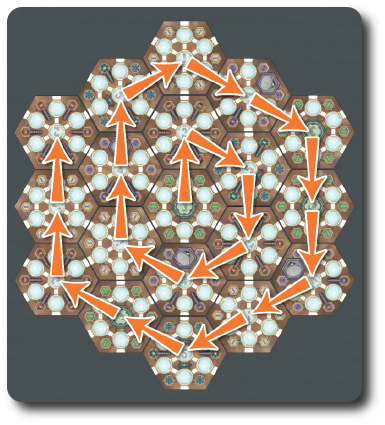
Third, place 1 blue Colonist marker on each of the available “dome” spaces found on the internal 7 Colony Module tiles. Any remaining Colonist markers are not used for the duration of the game. Make a pile for the Creep and Super Creep markers at this time, too.
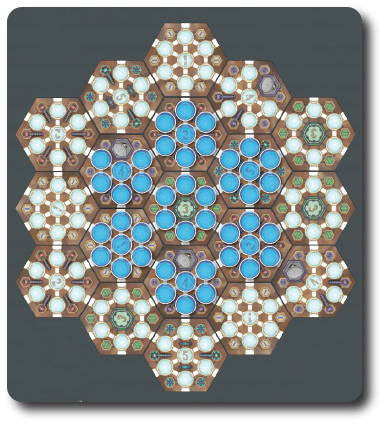
Fourth, take and shuffle the Rescue deck. Deal out to each player 2 cards. As this is a cooperative game, players should feel free to show and discuss their cards with everyone at the table, but they cannot trade cards at this time. Any setback Rescue cards dealt should be taken back, placed on the bottom of the deck, and a new card dealt to the player. Place the Rescue deck face-down to one side of the gaming area.
Fifth, each player now selects a Player pawn color of their choice. Hand to the player the Player pawn and the matching colored Core ring. Out of the 2 Rescue cards dealt to each player, one of the them will be the player’s “Core ability”. This is a special ability the player has access to every round. The card that is selected is placed in front of the player and the Core ring is placed on top of the card to identify it as a “Core ability”. Pass out the Game Reference tiles at this time, too.
Sixth, take the Evacuation Pod tile and place it next (but not connecting) to the Colony Module tiles. All the players should now place their Player pawns on the Evacuation Pod tile and determine who should go first and where the Evacuation Pod should initially dock to the colony (any outside tile is permissible).
When completed, your game board set up might look something similar to the following image.
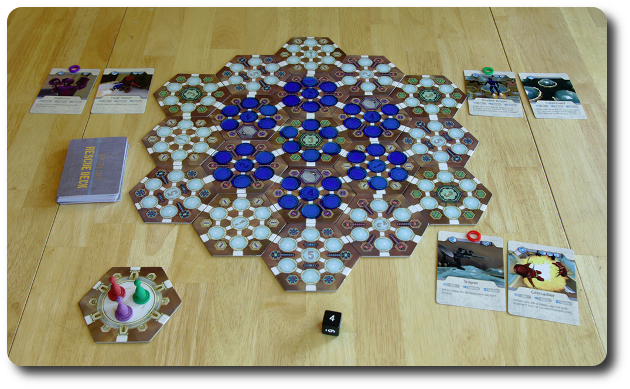
That’s it for game set up. Let’s go rescue the colonists!
A Quick Word on Resources
The Rescue card deck contains two different types of cards. These are abilities and setbacks. The majority of the Rescue deck contains beneficial cards (30 in total). The remaining 6 are setbacks and they will mess up the players’ plans.
Ability Rescue cards will list when it can be used (action) and how often (scope). Included on the ability Rescue card is helpful text that describes how the card is used in more detail. Ability Rescue cards can be used together to create some powerful actions. A player can play as many ability Rescue cards on their turn and individual actions as they choose, as long as the card’s ability can be triggered and are part of the action being taken. For example, a player can combine two “Rocket Boots” ability Rescue cards to get 7 actions or a player could combine “Juggernaut” and “Rocket Boots” ability Rescue cards to destroy a straight line of creeps in a single blow. Once an ability Rescue card is played, it’s discarded unless it’s the player’s “Core ability”. “Core abilities” always remain, are never discarded, and can be used as often as the ability allows.
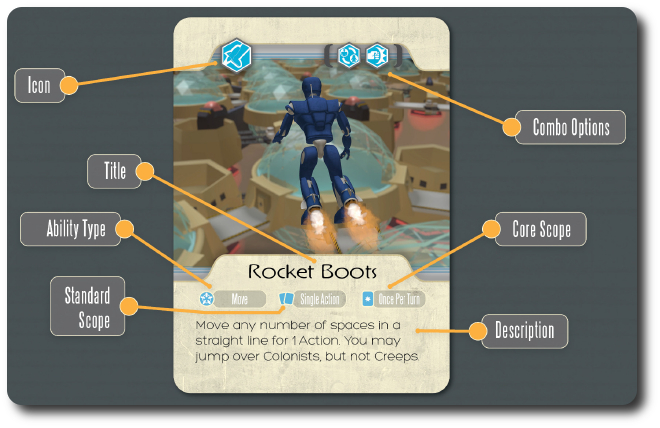
Setback Rescue cards will add more creeps, including the nasty super creep. But more importantly, setbacks impact all the players’ total number of actions and hand size limit. Contained on each setback Rescue card is a descriptive explanation and the condition it inflicts. The effects of the setback remain (as does the card) until the condition is removed. The effects of the setbacks can stack, too, meaning players must address the issues caused by the setback or risk having a bad situation turn even worse.
A Colony in Crisis
The players will be taking on the role of elite Emergency Response Robots (ERR’s). ERR’s are not just machines. They are programmed with a sophisticated artificial intelligence that allows them to quickly evaluate a situation and then develop a creative solution. ERR’s are also equipped with a wide variety of tools that they have at their disposal. But perhaps the most unique aspect of an ERR is their ability to work as a team. Each ERR is in constant contact with the other ERR’s which helps them coordinate their efforts. So far, all the ERR’s in the field have outstanding records and Orbital Mission Command believes that the current ERR team dispatched to assist Jupiter Deep will prove to be just as effective as all the others.
The game is played in turns with no set number of turns or rounds in a single game. A player’s turn is comprised of 4 steps which are summarized here.
Step 1: Take Actions
The first step allows the player to take up to 5 actions. The player is not forced to take all 5 actions if they don’t think it’s in their team’s best interest. The actions available to a player are summarized here. Note that some Rescue cards modify the basic actions.
Move
For one action, a player can move their Player pawn one space. A “space” in Jupiter Deep is considered 1 “dome” on a Colony Module tile (indicated by a circle on the Colony Module tile). Connecting the “domes” are bridges that radiate out like spokes. When one “dome” space connects to another via a bridge, they are considered adjacent. Moving from one “dome” to another is only possible if there if a bridge that connects them together. A player can also not travel through or stop on a “dome” that is currently occupied by another player, colonist, or creep. This means the players will have to coordinate their movements to ensure they don’t accidentally block safe passage. The one exception to this rule is the Evacuation Pod tile which can contain multiple Player pawns and Colonist markers.
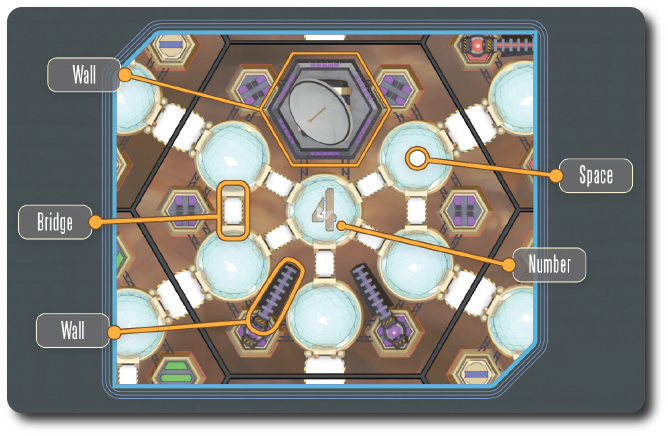
Shoot
For one action, the player can target a creep and destroy it at a molecular level. Any Creep marker located on the same Colony Module tile as the player’s Player pawn can be targeted, regardless if the “dome” the Creep marker is currently occupying is adjacent or even if there is a wall in the way. The number of “dome” spaces away is irrelevant, too. Players cannot target a Creep marker on an adjacent Colony Module tile unless they have the sniper ability (available from a Rescue card). When the creep is destroyed, it’s removed from the tile and placed to the side of the game playing area.
Command
For one action, the player can shout an order to any one colonist that occupies the same Colony Module tile as the player’s Player pawn or any adjacent Colony Module tiles. This is referred to as the player’s “Command Range”. Moving a Colonist marker one space (and, again, a colonist cannot occupy the same space as a Player pawn, another Colonist marker, or a Creep marker) is done in the same way a Player pawn is moved. A player can move a Colonist marker out of the player’s Command Range. As soon as they do, the Colonist marker can no longer be commanded until such time the player’s Player pawn is occupying the same Colony Module tile or is located in an adjacent Colony Module tile to the Colonist marker.
Trade
For one action, a player can trade as many Rescue cards as they like with another player who is within Command Range. The trades need not be one-to-one. As long as the same two players are trading, it only takes one action. As soon as the player trades with a new player, an additional action must be spent.
Step 2: Conversion
After the player has completed the first step (and a player is never required to use all 5 of their actions), any Creep marker that is in an adjacent “dome” space (connected via a bridge) to a Colonist marker infects the poor colonist. The Colonist marker is replaced with a red Creep marker. And, yes, this effect does “chain”, which means that if two or more Colonist markers are adjacent to each other, and one gets converted, so does its neighbor. Note that all colonists currently huddled in the Evacuation Pod tile are safe from conversion.
If a Colony Module tile is ever completely occupied by creeps (every “dome” space has a Creep marker on it), the Colony Module tile explodes and is removed from the game playing area. Remove all the Creep markers and place them back into a pile off to one side of the game playing area. A Colony Module tile will never explode if a Player pawn or a Colonist marker occupies it.
Step 3: Invasion
After all the conversions take place, the horror from below attacks the floating colony. The standard six-sided die is rolled by the player. On a result of 1 through 5, a single red Creep marker is added to the Colony Module tile that shares the same number as the one rolled, but only if the Colony Module tile is located on the outside portion of the colony (referred to as the “edge” in the game rules). The red Creep marker must be first placed on any “dome” space that is on the outer most edge of the Colony Module tile. If these “dome” spaces are not available (currently occupied by another creep or a Player pawn), the red Creep marker can be placed on any “dome” space on the Colony Module tile that was identified by the roll. A creep can always “bump” a colonist. If this happens, the Colonist marker is simply removed and replaced by the Creep marker. Any adjacent Colonist markers are not converted, but they will be unless commanded to move during the next player’s turn!
On a roll of “6”, one red Creep marker is added to every available “dome” space on a Colony Module tile that has at least 1 red Creep marker already on it!
Again, if a Colony Module tile is ever completely occupied by creeps (every “dome” space has a Creep marker on it), the Colony Module tile explodes and is removed from the game playing area. Remove all the Creep markers and place them back into a pile off to one side of the game playing area. A Colony Module tile will never explode if a Player pawn or a Colonist marker occupies it.
Step 4: Draw Resources
The final step a player takes on their turn is drawing a card from the Rescue deck. If the card drawn is an ability, it’s placed in the player’s hand, but cannot be played until the player’s next turn. If a setback card is drawn, it’s immediately resolved. Simply follow the instructions on the card and then place it in the discard pile if it does not have any lasting affects. If it does, leave it in play until it’s resolved. A player’s hand size limit, by default is 4 cards plus the player’s “Core ability”. The total number of cards a player can hold can be reduced by setbacks. Players must discard down to their hand size limit at the end of their turn, but the cards discarded are up to them.
The player’s turn is now over and the next player in turn order sequence going clockwise now gets their turn starting with step 1 above.
Winning and Losing the Game
The players win the game if they save 28 or more colonists and get all members of their team off the doomed colony. Only 7 colonists can be rescued at a time, however. Once the Evacuation Pod tile has 7 Colonist markers, it can be detached. A player need not have their Player pawn on the Evacuation Pod to initiate the detachment. The Colonist markers that are on it are placed in a saved pile to one side of the game board to help keep track of how many have been rescued. The Evacuation Pod will not return and attach back to the colony again until it’s the player’s turn that commanded the 7th colonist to board the Evacuation Pod. At anytime during their turn, the player can dock the Evacuation Pod to any outer most edge to any Colony Module tile. This includes orphaned Colony Module tiles that are no longer connecting to the main portion of the colony due to modules self-destructing. Any player who had a Player pawn located on the Evacuation Pod cannot take any actions during step 1 on their turn until such time the Evacuation Pod reattaches itself to the colony.
The players can lose the game two different ways. The first is if enough colonists are lost due to a high number of creep conversions making it mathematically impossible to save 28 of them (there’s no way to cure a converted colonist). Because the colony is randomly built at the beginning of each game, the total number of colonists will differ. Players need to keep track of how many colonists remain at all times! The second way the players can lose is if all the “3” OR all the “4” Colony Module tiles are destroyed due to creep infestation. Colony Module tiles with a “3” on them provide power to the colony, including the engines that keep it afloat above the gas planet below. If the colony no longer has power, its orbit quickly deteriorates and it starts to fall. Colony Module tiles with a “4” on them contain powerful radar dishes that are necessary for all communication, including the safe detachment and reattachment of the Evacuation Pod. If the radar dishes are destroyed, the Evacuation Pod can no longer be piloted, which means the players and the colonists are stranded.
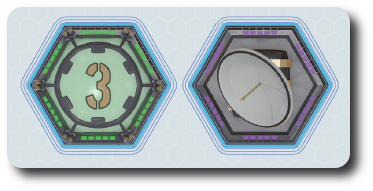
Game Variants
There are several game variants provided in the rules to adjust game play. We will summarize them here.
- Robot Vulnerability: The failsafes are off! If a Colony Module tile is filled with Creep markers and the only free “dome” space is being occupied by a Player pawn, the module self-destructs! The player will return to the game the next time the Evacuation Pod returns to the colony.
- Fast Creeps: The conversion step will occur AFTER the invasion step! This means that new creeps will find their way onto the colony AND THEN infect the colonists! Prepare for an epic battle!
- Ultimate Heroes: To win the game, you must save ALL the colonists!
- Polite Colonists: With this game variant, Player pawns and Colonist markers can move past each other (do not block movement), but cannot occupy the same “dome” space at the same time.
House Rules
We added two rules that made the game a bit more interesting and intense without seemingly upsetting any game balance issues.
- Strong Creeps: The Green super creeps take 2 hits (2 attack actions) to be destroyed.
- Failed Destruction: Instead of the Colony Module tiles exploding after a mass infection, the failsafes…well…fail, and the Colony Module tile remains totally infected, becoming a hotbed of creeps.
To learn more about Jupiter Deep, visit the game’s web page at Whirling Derby Games or at the Game Crafter.
Prediction
Cooperative and semi-cooperative games can be a “big hit” or a “huge miss” with players. By and large, the theme and narrative of the game seldom plays any role in an individual player’s final level of endorsement. Instead, it’s the level of control players have over the game that will tip a player’s opinion. If a cooperative or semi-cooperative game is found to be too easy or too hard for the players to tackle (with or without an adjustable difficulty game mechanism in play), the resulting vote is usually not very positive. On the other hand, if the game challenges and victory can be obtained only through true cooperative team play, the game gets a lot of smiles.
From what I have read, I believe Jupiter Deep will do very well with the Child and Parent Geeks. I am not yet certain of the game’s overall difficulty to suggest if it will challenge and please the Gamer Geeks. At the least, I think the Gamer Geeks will enjoy it as a light cooperative.
Teaching Jupiter Deep is not overly difficult, but do expect the younger Child Geeks and non-gamers to be a bit lost at first. Since this is a cooperative game, it’s perfectly reasonable to assist other players. Just make sure that none of the players cross that line that divides ” helpful team members” from “boss players”. It’s a well-known fact that cooperative game play can sometimes result in a dominant player emerging that attempts to lead the pack. Every player should determine what they want to do and act accordingly based on their own judgement, but asking other team members for input is just plain smart.
After teaching the game to my two oldest little geeks, I asked them for their thoughts on Jupiter Deep so far.
“Really neat cooperative game! I really like how I can combine the Rescue cards together to create super attacks!” ~ Liam (age 8)
“And I really like how I get to be a robot and fight aliens!” ~ Nyhus (age 5)
My little rescue team is ready to lock, load, and save the colony! Let’s see if our shared experience results in a glorious adventure or a painful misadventure.
Final Word
For the Child Geeks, Jupiter Deep was found to be a lot of fun. Child Geeks as young as 5-years-old were able to join in on the excitement and had a blast being part of the team. The younger players did require a bit of help when keeping track of how many actions they had left and reading the cards, but they understood the game well enough to make their own decisions and contributed to the conversations at the table when discussing strategies. Every Child Geek told me they felt like an important member of the team and liked how much “they could do” on their turn. While I do not personally consider Jupiter Deep to be a “children’s game”, the Child Geeks certainly claimed it as their own. They even went so far as to name their ERR’s based on their color. For example, my 5-year-old named his ERR “Firecat” (because it was red). So awesome. All the Child Geeks voted to approve Jupiter Deep and have been enjoying it every time it gets to the table…which is often.
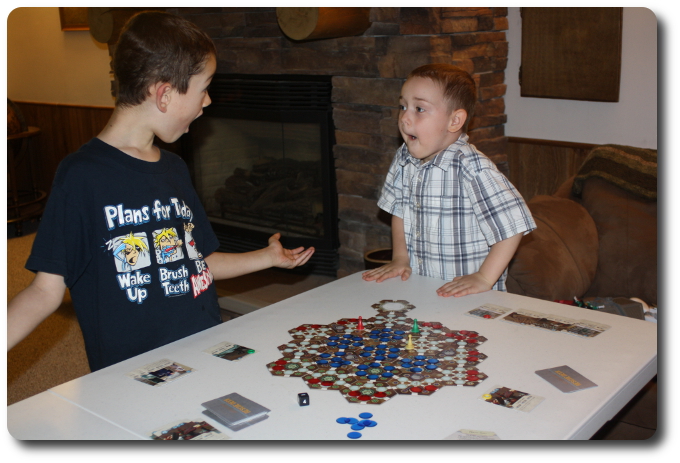
My two little geek congratulate themselves on successfully rescuing their first batch of colonists
The Parent Geeks really enjoyed Jupiter Deep, showing the same level of excitement as the Child Geeks. They wanted to immediately give it their approval after they played the game once with their peers and then again when they played it with their families. “The kids and I really love it – automatic ‘heck yes’ from me!” exclaimed one Parent Geek. Another Parent Geek said that they thought the game not only played well, but really enjoyed how there was no luck involved. When I asked him if they thought the random card draw or roll of the die was an element of luck, he said no and stated, “Every card I drew was valuable to someone on my team, and randomness has nothing to do with luck.” The only negative comment we received was that the game too easily allowed for one player to dominate the rest. I countered by saying that had nothing to do with the game, but was the fault of the players at the table. We argued about that for a bit until we both mutually agreed that the game required teamwork and sometimes the best teams have a leader. The Parent Geeks approved of Jupiter Deep and were sorry to see it leave the table when it came time to play a new game.
The Gamer Geeks enjoyed their time with Jupiter Deep, but their level of enthusiasm for the game started to dwindle when they realized that they could beat the game every time they played it. The Gamer Geeks know their stuff when it comes to tactical movement and strategic group play. The creeps never had a chance nor were they ever a threat. That’s when I introduced the “Fast Creeps” and “Robot Vulnerability” game variants. Putting these two new rules in play improved the game’s difficulty enough to bring the Gamer Geeks back to the gaming table. But, again, the Gamer Geeks dominated and were able to win every time they played the game. The only time they did not was when we changed the victory condition to saving all the colonists. You mess up once and the game was over. The Gamer Geeks found this to be a bit too extreme. When it came time to give the game their endorsement, the Gamer Geeks were silent, then one of them spoke up. “Here’s the thing. This game doesn’t challenge me anymore, but I’m having a great time playing it with you guys. I give it a thumbs up.” The other Gamer Geeks agreed and gave it their approval as well. Jupiter Deep was found to be a fun and light cooperative game that did require teamwork, communication, and synchronization.
Jupiter Deep benefits from two very important points. First, cooperative and semi-cooperative games are fairly well-known and popular in the gaming hobby world right now. As a result, most players are already familiar with these types of games and approach it with a predisposed assumption regarding the game play. On this point, Jupiter Deep delivers an enjoyable cooperative game experience. Second, the game designer has reduced what a player can do on their turn using a set number of allocated actions without reducing a player’s effectiveness on the game board. Actions are used and managed like a resource. Players must think through their moves and actively discuss what they plan on doing with other players or risk reducing the effectiveness of other players. This means everyone must cooperatively work as a tactical team. Attacks and movement must be coordinated to save the colonists or the players will fail. Communication is exceedingly important in the game and demands a level of social play that makes the entire game playing experience much more engaging and seemingly involved. The end result is a game that leaves players feeling like they really are part of a crack rescue team instead of just moving bits around the board.
But I don’t think Jupiter Deep is perfect.
What Jupiter Deep needs is more of what it already has. More Colony Module tiles and more Rescue cards. The level of difficulty of the game is currently capped until such time more setbacks and Colony Module tiles are included that dynamically shift the game in or out of the players’ favor during play. The game could also benefit from having different types of creeps available. For example, some creeps that require two shots to kill (we created a House Rule to satisfy this need). What the game currently provides is challenging, but not impossible. Veteran players will have no problem beating this game, and a group of players will only lose if they don’t communicate. A higher level of unpredictability is necessary to keep all the players working to beat the game as fast as they can. It shouldn’t be enough to simply keep the creeps under control. There should be unknowns that cannot be accounted for, surprises, and a foreboding sense that the longer the players are in the colony, the worse it’s going to get. To put it another way, Jupiter Deep needs to put more stress on the players.
Would I recommend Jupiter Deep? Without hesitation. It’s an enjoyable game that provides exciting game play, lots of fun at the table, and some killer actions. The game has always left me satisfied – for what it is – and all the players who have joined me said they had a good to great time playing it. There are certainly more complicated cooperative and semi-cooperative games available, but that should not suggest they are better or Jupiter Deep is somehow less. It’s a solid game, was designed intelligently, and plays smoothly. You couldn’t ask more from a game, but that doesn’t stop me from doing so. There’s just no pleasing some people…
This game was given to Father Geek as a review copy. Father Geek was not paid, bribed, wined, dined, or threatened in vain hopes of influencing this review. Such is the statuesque and legendary integrity of Father Geek.




looks like an interesting game
It’s a fun one, but always left me thinking there could be more added to it. Like I said in the review, “there’s just no pleasing some people.”
I really got a kick out the Child Geeks naming their robots. Sounds like you all had a fun time with it!
Tiny note: You mentioned in the Overview that it was a finalist in the Co-Op challenge, but it was actually also the first place winner. =)
Well, well! I knew the game did well, but I was not privy to the final results of the contest. Excellent! I have updated the review to reflect that the game was a finalist AND the first place winner.
Thank you very much for the update!
This sounds exactly like the kind of game my Wife and I would like to play together! I also love that you can add up to 5 additional players after that. There aren’t a ton of co-op type games out there and it tends to be my preference. That or lightly competitive.